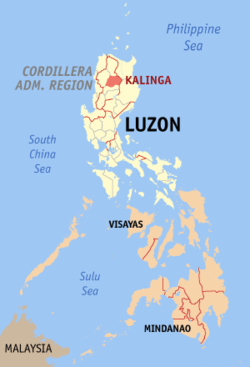Kalinga Ethnoarchaeological Project
The Kalinga Ethnoarchaeological Project (KEP), based in the Cordillera Mountains of the Philippines, was one of the longest-running ethnoarchaeological projects in the world.[1] It was initiated by William Longacre, professor at the University of Arizona, in 1973. Lasting for almost 20 years, research focused on pottery production, use, exchange, and discard, and was carried out by Longacre and his team of Kalinga assistants, archaeology students, and colleagues.[2]

Purpose
Generally, Longacre’s research assessed the relationship between the learning framework of pottery manufacture and the presence of decorative attributes.[3]
The Kalinga Ethnoarchaeological Project had the following objectives:
- (1) to develop fine-scale measures for recording stylistic variability in Kalinga pottery; and
- (2) to understand and record the social context of pottery making.[4]
Methods employed by project ethnoarchaeologists included participant observation, as well as mapping and household census-taking of pottery-making villages such as Dangtalan and Dalupa.[1]
Background
1973
The original site visit by Longacre, during the summer of 1973, aimed to determine that pottery-making in Kalinga was happening at that time on a household level. It was known to Longacre that the Kalinga were a pottery-making society. With support from the National Science Foundation, Longacre returned to the Kalinga for a full year of fieldwork from 1975-1976.[5]
1979-1980
Longacre planned to return from 1979-1980, but was prevented from doing so by political instability in the region. Instead, two Kalinga colleagues carried out the 1979–1980 pottery census and provided data to Longacre.[1]
1987–1988
When Corazon Aquino became President, her first presidential decree was the cancellation of the controversial Chico River Hydroelectric Dams project. With political instability in Kalinga then subsiding, Longacre was able to return to field. He was accompanied by a team of graduate students from the University of Arizona, the University of the Philippines, and staff archaeologists from the National Museum of the Philippines.[1]
Three communities, Dangtalan, Dalupa and Guina-ang were the focus of project research. Part of the 1987–1988 Kalinga project research concentrated on aspects of ceramic production. The following were retrieved from different data-collection strategies and survey instruments done for all three principal communities:
- (1) a village map;
- (2) a household pottery census; and
- (3) a household economic profile [1]
since the late 1980s
Kalinga collections are now housed at the Arizona State Museum in Tucson. Research and analyses have continued, as several members of the project have visited Kalinga at least once since their primary fieldwork was conducted. However, the KEP has not launched a large-scale field season since 1987.[1]
Bibliography
Beck, Margaret E. "Midden ceramic assemblage formation: A case study from Kalinga, Philippines." American Antiquity (2006): 27-51.
Graves, Michael W. "Community boundaries in late prehistoric Puebloan society: Kalinga ethnoarchaeology as a model for the Southwestern production and exchange of pottery." The Ancient Southwestern Community: Models and Methods for the Study of Prehistoric Social Organization, University of New Mexico Press, Albuquerque (1994): 149-170.
Longacre, William A. "Kalinga pottery: an ethnoarchaeological study." Pattern of the past: Studies in honour of David Clarke (1981): 49-66.
Longacre, William A. and James M. Skibo. Kalinga Ethnoarchaeology: Expanding Method and Theory. Smithsonian Institution Press, Washington, DC (1994).
Longacre, William A. and Miriam T. Stark. "Ceramics, kinship, and space: A Kalinga example." Journal of Anthropological Archaeology 11.2 (1992): 125-136.
Stark, Miriam T. "Ceramic production and community specialization: A Kalinga ethnoarchaeological study." World Archaeology 23.1 (1991): 64-78.
Stark, Miriam T., Ronald L. Bishop, and Elizabeth Miksa. "Ceramic technology and social boundaries: cultural practices in Kalinga clay selection and use." Journal of Archaeological Method and Theory 7.4 (2000): 295-331.
Stark, Miriam T., and James M. Skibo. "A history of the Kalinga ethnoarchaeological project." Archaeological anthropology: Perspectives on method and theory (2007): 93-110.
Tani, Masakazu and William A. Longacre. "On methods of measuring ceramic uselife: A revision of the uselife estimates of cooking vessels among the Kalinga, Philippines." American Antiquity (1999): 299-308.
References
- 1 2 3 4 5 6 Stark, MT, Skibo, JM A history of the Kalinga ethnoarchaeological project. In: Skibo, JM, Graves, M, Stark, M eds. (2007) Archaeological anthropology: Perspectives on method and theory. University of Arizona Press, Tucson, pp. 93-110
- ↑ Wandsnider, LuAnn, "Review of Kalinga Ethnoarchaeology: Expanding Archaeological Method and Theory" (1995). Anthropology Faculty Publications. Paper 21. Retrieved from http://digitalcommons.unl.edu/anthropologyfacpub/21
- ↑ Longacre, WA (1970) Archaeology as anthropology: A case study. University of Arizona, Tucson
- ↑ Longacre, WA Kalinga pottery making: The evolution of a research design. In: Leaf, MJ eds. (1974) Frontiers of anthropology. Van Nostrand, New York, pp. 51-67
- ↑ Longacre, WA, Skibo, JM eds. (1994) Kalinga ethnoarchaeology: Expanding archaeological method and theory. Smithsonian Institution Press, Washington, DC
